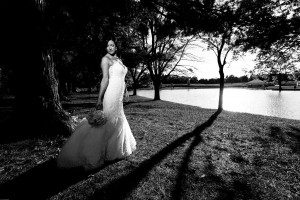Wedding – Hanna and Brad on a Perfect Day
Simplicity is the best approach to wedding photography. As my style has evolved over the years, I find myself being drawn to a minimalistic look that has a stark and beautiful effect.
The drama is about the people in the image and they should be the attention points. One of the ways to achieve this is by using a shallow depth of field to create a milky blurry background. The focus is never on the surroundings but on the people.
Clean, stark, minimal, single focus, distraction free- these are terms I can apply to most of my pictures that I can control.
Most modern portraits are shot in soft light. Soft lighting is more forgiving, more flattering and easier for beginners to master. So does that mean there’s no place for hard light in portrait photography? Just look at any collection of Hollywood portraits from the 1930s and you’ll have your answer. Golden age movie-stars often preferred to be shot in hard light, because hard light is dramatic and seductive. Drama and seduction, as we still understand today, help sell movie tickets. But shooting in hard light can be tricky. Here’s how to create hard light portraits that will give your subjects a glamorous, dramatic quality.
What is hard light?
Soft light is diffused, meaning that shadows are absent or indistinct. Soft light can make a subject look younger and can downplay flaws in the skin. It also looks flatter than hard light. Hard light, on the other hand, is more contrasty. In hard light, shadows have harder edges and greater definition. Subjects shot in hard light tend to look more three dimensional.
First, learn how to distinguish a good hard-light subject from everyone else
Not every subject is a good candidate for hard light. A person with blemishes, for example, deep wrinkles or otherwise less-than-perfect skin is not going to appreciate the results of a photo session in hard-light, since this type of lighting tends to accentuate everything that is wrong with your skin. Even subjects with enviable skin can benefit from a little help in hard light; make-up will reduce reflections on the skin that will translate into blown-out highlights in the finished portrait.
While mastering hard light portrait photography, it’s a good idea to shoot half your photos in hard light and the other half in soft. This will help you understand which subjects are naturals for these types of portraits and which ones just aren’t. And you won’t end up with a disappointed subject because you made the wrong judgment call.
Now ditch those soft boxes and umbrellas
Without soft boxes and umbrellas, you’ll instantly transform your lighting equipment from soft light to hard light. You can use a single hard light source for very dramatic photos, which will create a background that falls rapidly into blackness–but you’ll have more options if you stick with a basic portrait lighting setup (sans diffusers) with a key light and a fill light. Then you can experiment until you get the results you’re looking for.
Be aware of shadows, but don’t be afraid of them
With hard light, portrait photography becomes a game of shadows. Hard light will create hard shadows, and while some of them help create the effect you’re looking for, others are just plain ugly and need to be exorcised from the image. And example is that harsh “halo” type shadow like the one you get with a standard on-board camera flash. You’ll get this with hard studio light, too, so you’ll need to angle your camera or change the position of the light so the shadow falls out of the frame.
